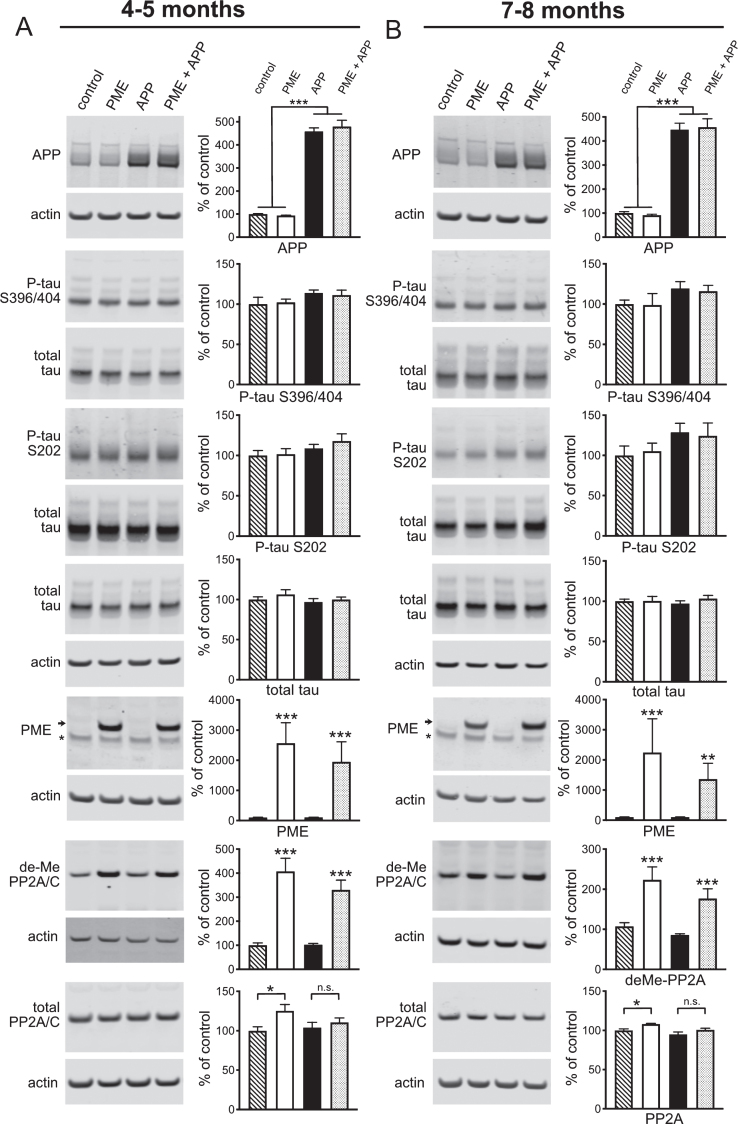Fig. 7.
The effect of PME overexpression on APP expression, tau phosphorylation and PME protein levels in Tg2576 mice. A, B) Representative western blots showing anti-APP, phospho-tau serine 396/404 and serine 202, total tau, PME, demethylated PP2A/C and total PP2A/C immunoreactivity in hippocampal homogenates prepared from 4-5 (A) or 7-8-month-old (B) control, PME overexpressing, Tg2576 APP transgenic, or PME overexpressing/APP transgenic mice together with corresponding histograms showing average normalized immunoreactivity (±SEM) in each group. APP genotype significantly affected APP expression (2-way ANOVA with APP and PME genotype as factors: F(1,20) = 564.7, p < 0.0001 for 4-5-month-old mice and F(1,20) = 251.3, p < 0.0001 for 7-8-month-old mice). Sidak’s multiple comparisons showed no significant differences in APP expression between control and PME groups (p = 0.9504 for 4-5 and p = 0.9542 for 7-8-month-old mice) or between APP and PME + APP groups (p = 0.5961 for 4-5-month-old and, p = 0.9313 for 7-8-month-old mice). Animals carrying an APP transgene showed a trend for increased tau phosphorylation at serine residues 396/404 (APP:113.3±3.82, PME + APP: 111.3±6.05 versus control: 100±8.58, PME: 102.1±4.08 at 4-5 months, and APP:119.5±8.42, PME + APP: 115.9±7.41 versus control: 100±4.98, PME: 99.0±14.06 at 7-8 months) that did not reach statistical significance (2-way ANOVA with APP and PME genotype as factors: F(1,20) = 3.725, p = 0.0679 for 4-5-month-old mice and F(1,20) = 3.806, p = 0.0652 for 7-8-month-old mice), and was not affected by PME overexpression (Sidak’s multiple comparisons between APP and PME + APP groups: p = 0.9499 for 4-5-month-old and, p = 0.9554 for 7-8-month-old mice). Similarly, animals carrying an APP transgene showed a trend for increased tau phosphorylation at serine residue 202 (APP:108.9±4.78, PME + APP: 117.9±8.82 versus control: 100±6.13, PME: 101.6±6.87 at 4-5 months, and APP: 128.7±11.25, PME + APP: 124.3±16.02 versus control: 100±11.51, PME: 105.2±10.04), that did not reach statistical significance (2-way ANOVA with APP and PME genotype as factors: F(1,20) = 3.423, p = 0.0791 for 4-5-month-old mice and F(1,20) = 3.721, p = 0.0680 for 7-8-month-old mice), and was not affected by PME overexpression (Sidak’s multiple comparisons between APP and PME + APP groups (p = 0.5895 for 4-5-month-old and, p = 0.9750 for 7-8-month-old mice). Neither PME nor APP transgenes significantly affected endogenous tau levels (2-way ANOVA for effect of PME transgene with APP and PME genotype as factors: F(1,44) = 1.098, p = 0.3005 for 4-5-month-old mice and F(1,44) = 0.6706, p = 0.4173 for 7-8-month-old mice; 2-way ANOVA for effect of APP transgene with APP and PME genotype as factors: F(1,44) = 0.6987, p = 0.4077 for 4-5-month-old mice and F(1,44)<0.0001, p = 0.9985 for 7-8-month-old mice). Total PME expression (endogenous + transgenic) showed a significant effect of PME genotype (2-way ANOVA with PME and APP genotype as factors: F(1,20) = 20.39, p = 0.0002 for 4-5-month-old mice and F(1,20) = 7.611, p = 0.0121 for 7-8-month-old mice). Sidak’s multiple comparisons showed no significant differences in PME expression between control and APP groups (p > 0.9999 for 4-5 and 7-8-month-old mice) or between PME and PME + APP groups (p = 0.6028 for 4-5-month-old and, p = 0.5471 for 7-8-month-old mice). Transgenic PME overexpression significantly increased the amount of PP2A catalytic subunit that was demethylated at Leucine 309 (2-way ANOVA with PME and APP genotype as factors: F(1,20) = 59.54, p < 0.0001 for 4-5-month-old mice and F(1,20) = 24.55, p < 0.0001 for 7-8-month-old mice). Sidak’s multiple comparisons showed significant differences in demethyl-PP2A/C immunoreactivity between control and PME groups (p < 0.0001 for 4-5 and p = 0.0017 for 7-8-month-old mice) or between APP and PME + APP groups (p = 0.0003 for 4-5-month-old and, p = 0.0119 for 7-8-month-old mice). Transgenic PME overexpression also led to a small but significant increase in the total amount of PP2A catalytic subunit in the PME relative to control group but not the PME + APP relative to APP alone group (2-way ANOVA for effect of PME with PME and APP genotype as factors: F(1,20) = 6.077, p = 0.0229 for 4-5-month-old mice and F(1,20) = 10.73, p = 0.0048 for 7-8-month-old mice). Sidak’s multiple comparisons showed significant differences in total PP2A/C immunoreactivity between control and PME groups (p = 0.0230 for 4-5 and p = 0.0313 for 7-8-month-old mice) but not APP and PME + APP groups (p = 0.7376 for 4-5-month-old and p = 0.1374 for 7-8-month-old mice). For all blots band intensities in each lane were normalized to corresponding actin or total tau immunoreactivity in that lane, and values were expressed as a percentage of the mean of the control group (N = 6 per group).

